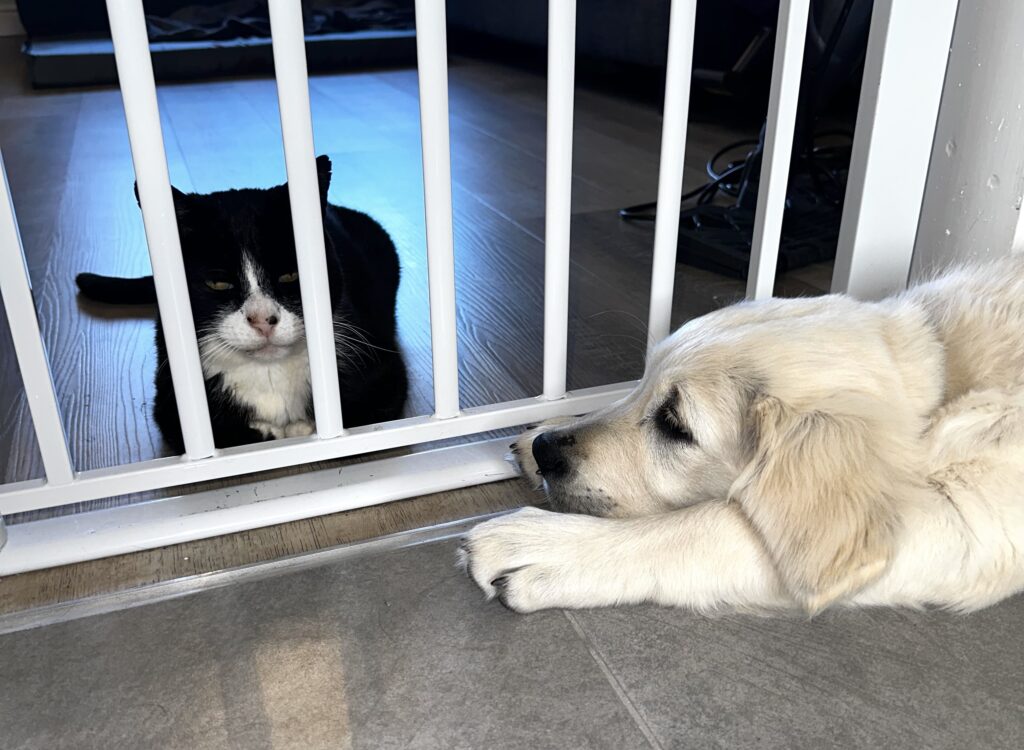Introducing a Puppy to a Resident Cat
 Copyright. Photo courtesy of Amy Crossley.
Copyright. Photo courtesy of Amy Crossley.When introducing a puppy to a resident cat, good preparation and gradual, supervised introductions increase the chance of a positive outcome.
Stage One: Preparation
- When choosing a new puppy, consider looking for a dog breeder that has a family cat and has appropriately habituated the puppy to them. Or when rehoming a rescue dog, try and find out if they have previously lived and had a harmonious relationship with cats and how they respond to unfamiliar cats.
- Before the dog’s arrival set up a safe refuge for the cat (https://petcourses.co.uk/free-resources/creating-a-refuge-room-for-cats).
- Create a separate safe space for the dog too.
- Puppies and adult dogs can be crate trained using principles aligned with positive reinforcement training. Ask the breeder if they can begin the process before you pick them up.
- Purchase a house-line as these can come in useful to control the dog’s movements and prevent chase behaviours.
- Place newly purchased doggy paraphernalia away from the cat. Introduce the items gradually but only after transferring the cat’s scent to them before and during their appearance (https://petcourses.co.uk/free-resources/the-importance-of-a-cats-scent-profile).
- Install tall baby-gates to control the dog’s movements and to segregate them safely. Ideally choose one that has an integrated, lockable, cat-flap in the design so that after training the cat has the freedom to come and go.
- Cultivate an awareness of feline (and canine) body language in order to interpret signalling so interactions can be stopped at the earliest sign of stress.
Stage Two: Introducing Scent
- Give the cat (and dog) a few days to settle. Allow them freedom to access their safe spaces but keep them separated.
- During this period share your time and attention between them, this way they won’t feel neglected and their scent will be introduced to each other via your hands and clothing.
- Take the time to teach a dog a good recall and some other basic training so they get used to listening and responding to you.
- Use scent cloths or cotton gloves to stroke them both with and place the cat’s cloth in the dog’s vicinity and vice versa. Make sure they are not placed close to their key resources (food, water, beds etc.).
- Let them explore the scent at their leisure.
- To help create positive associations, pair the scent with something they enjoy.
- Use positive reinforcement in both species for positive responses to the scent cloths.
- If everything goes smoothly, progress to stage three.
Stage Three: Eye to Eye Contact
- Follow and adapt the information provided in Introducing new Cats to a Home with a Resident Cat(s) – stage three (https://petcourses.co.uk/free-resources/introducing-new-cats-to-a-home-with-a-resident-cats).
- Keep the dog on a house-line (or regular lead) so it can’t rush up to the boundary and frighten the cat.
- It’s important to keep them both engaged in something pleasant. Short positive sessions are best.
- Practise recall with your dog, rewarding them generously for coming to you
- Don’t be tempted to rush to the next stage. Build on this stage, gradually allowing the dog closer. If all goes well progress to stage four.
Stage Four: Face to Face Contact
- Follow and adapt the information provided in Introducing new Cats to a Home with a Resident Cat(s) – stage four.
- BUT, in addition to the baby-gate, ensure the dog is on their house-line to prevent them charging up to the barrier.
- Before opening the door and to encourage the cat to feel safer, the dog can be placed inside their crate. However, this is only recommended if the dog has been properly crate trained, is comfortable with the door being shut and happy in the cat’s presence.
- Whilst the dog is contained in their crate provide them with a puzzle feeder and actively monitor their behaviour.
- Never allow the cat to ‘taunt’ or frighten the dog – some nervous dogs can be more fearful of the cat than the other way round!
- If things progress well, allow the dog out of the crate, continuing to use the house-line as a safe method of control.
- Continue to actively monitor and intervene if necessary.
- Over time your dog and cat should gradually get used to each other and will eventually be able to interact freely.
- A similar process can be followed for adult dogs but this can carry a greater risk. Muzzle training is a sensible health and safety precaution (https://petcourses.co.uk/free-resources/training-your-dog-to-accept-a-muzzle).
*A house-line is a training aid that helps control or manipulate the dog’s movements in a safe manner. These long, narrow, light-weight lines are around two and a half metres long and are attached to the dog’s collar. Under supervision they trail along the floor until needed.